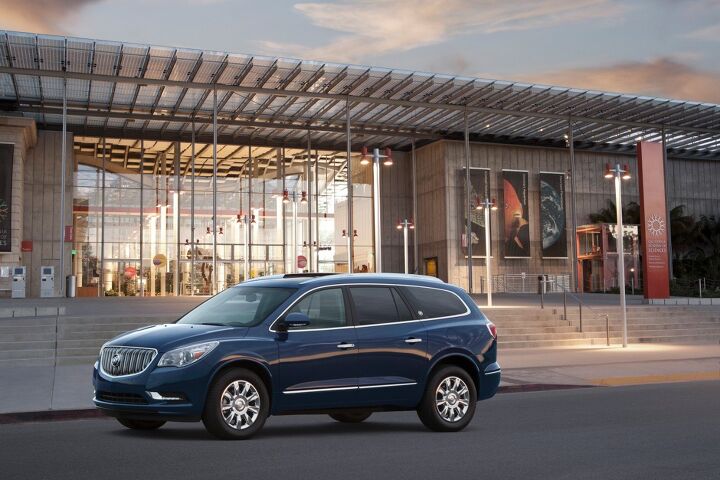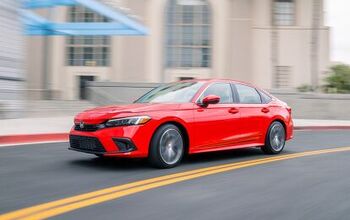Thirsty Thursday: GM's Full-Size Crossover Fuel Economy Woes Spark Lawsuit

On the heels of a stop sale order and subsequent rush to reprint Monroney stickers with correct EPA fuel economy ratings, General Motors is working on a plan to compensate buyers of the 2016 Chevrolet Traverse, GMC Acadia and Buick Enclave.
Seeking to smooth any ruffled feathers, GM expects to announce a plan to dealers and customers within the next seven days, according to Automotive News.
That assurance isn’t enough to placate some owners of the full-size crossover, as GM was slapped with a prospective class-action lawsuit on Tuesday.
The suit, which seeks compensation for buyers of affected models, alleges GM concealed the vehicles’ real fuel economy and customers overpaid for them as a result.
McCuneWright, which those of us with long memories may remember as one of the law firms representing customers in the Hyundai/Kia fuel economy flap four years ago, filed the complaint on behalf of Florida resident Sean Tolmasoff, who purchased a 2016 Traverse last month.
Tolmasoff “would not have purchased the Traverse or would have paid substantially less for it” if the correct fuel economy numbers were displayed, the suit claims.
Faulty “data transmission” is being blamed for overstating the fuel economy on GM’s full-size crossovers by one to two miles per gallon. The correct EPA ratings for all-wheel-drive models of all three GM crossovers are 15 mpg city/22 highway/17 combined. The incorrect label showed 17 mpg city/24 highway/19 combined.
After first failing to disclose why mileage dropped on new vehicles with the same powertrain as older models, GM told Automotive News that new “emissions-related hardware” was added to 2016 models.
Hyundai/Kia paid $395 million to settle their suits, which encompassed nearly a million vehicles. At roughly 60,000 vehicles currently affected, GM’s thirsty crossovers make up a fraction of that number. However, about two million of the things have left dealer lots to blight our landscape since they went on the market nearly a decade ago.
If past fuel economy numbers also turn out to be inaccurate, it could spell a much bigger problem for The General.

Matthew buys, sells, fixes, & races cars. As a human index of auto & auction knowledge, he is fond of making money and offering loud opinions.
More by Matthew Guy
Latest Car Reviews
Read moreLatest Product Reviews
Read moreRecent Comments
- TheEndlessEnigma My 2016 FiST has been the most reliable car I've owned.
- MaintenanceCosts I already set out total costs, so this time I'll list what's had to be done on my cars (not counting oil changes, recall, or free services):2019 Bolt (25k mi): new 12v battery, pending tires & battery cooling service2016 Highlander (from 43k to 69k mi): new front rotors, new pads all around, new PCV valve, 2x 12v batteries, light bulbs, pending tires2011 335i (from 89k to 91k): new valve cover gasket, new spark plugs, light bulbs, pending rear main seal1995 Legend (from 185k to 203k): timing belt/water pump, new EGR valve + pipe, struts, strut bushings, drive axles, tie rods, rear control arms, other suspension bushings, coolant hose & brake lines throughout, belts, radiator, valve cover gaskets, new power antenna, 12v battery, coils, spark plugs, tires, rear pads... it's an old car!
- VoGhost Consistent with CR's data. I've spent about $150 total on the Model 3 in six years of ownership, outside of tires.
- VoGhost It's just plain sad that Posky doesn't know that EV batteries are warrantied for 8 years / 100K miles.
- Jkross22 It used to be depreciation was the most expensive part of car ownership. Seems like those days are over (New EVs and lux cars excluded). Maintenance + insurance have taken over. Dealerships offering 2 years of maintenance means nothing. That's $200 tops. It's the unexpected repairs - a wiring harness, computer module, heater core, AWD problems - that will cost dearly. Brakes can be expensive since many cars now can't have rotors resurfaced. Even independents are charging a lot for this work.


































Comments
Join the conversation
I'm currently test driving gen 1 Sequoias as my next do-it-all vehicle (and future baby carrier), I even made a very brief foray into looking at these GM fullsize CUVs. It makes an interesting comparison to a GM Lambda, the two are closer than one might suspect in a number of measurements: Sequoia 4wd MPG: 15c/18h Traverse AWD MPG: 15c/22h Overall Length Sequoia 203.9" Traverse 203.7" Curb weight: Sequoia 4wd: 5300lb Traverse AWD: 4956lb Cargo volume (all seats folded/3rd row folded/all seats in use) Sequoia: 128.1/65.3/26.6 Traverse: 116.3/70.3/24.4 Towing: Sequoia 4wd: 6500lb Travese AWD w/ towing: 5200lb (My guess is that the Toyota with its RWD w/solid rear axle and much torquier V8 is happier at its max than the Traverse) Ground clearance: Sequoia: 10.6" Traverse: 7.2" So the big win is as expected fuel economy on the highway due to massively better aerodynamics and a smaller displacement motor with tall gearing, but it is perhaps not as big of a gap as one might expect, and their similar weight equalizes things around town, where the V8 works less hard compared to the lacking-in-low-rpm torque V6. Where I think the CUV argument falls apart a bit is supposed packaging advantages when compared to BOF SUVs. Having sat in all rows of both vehicles, I'd call it a draw in terms of legroom and layout. And as we see, cargo capacities are very similar, with an edge to the Sequoia in max cu ft. Caveat time: Sequoia's third row doesn't fold flat into the floor, they have to be removed and stored to achieve max. volume. The Traverse probably handles better with less lean, but I have to say the Sequoias I've driven are very civilized and smooth compared to my measuring stick of my '96 4Runner. The Sequoia is (to me) ultimately the much more versatile vehicle owing to its massively better offroad capabilities. This is a non-factor to most buyers. basically entirely off topic, just 'sperging out with some number crunching :p
Well, first off, I doubt that it was a customer who was dis-satisfied. It was a plaintiff's lawyer who saw an opportunity and who knows that the first lawyer to file one of these cases usually gets "control" of the whole mess and a bigger share of the multi-million dollar attorney fee pile. That said, something as large as these CUVs claiming to get 24 mpg in AWD form with a gasoline engine would certainly attract the fuel economy shopper's attention. Since, as others have noted, it's pretty hard to do better than 22 mpg on the highway with a vehicle of this size and type. Even my '08 Honda Pilot is lucky to get 22 mpg under ideal highway conditions (i.e. less than 65 mph, reasonably flat terrain and not fully loaded). As for those who argue that the EPA tests are meaningless because they don't replicate real-world experience; I disagree. At least the EPA test is a uniform yardstick applied to all vehicles. However, I am concerned that Ford's "ecoboost" turbocharged engines seem to fall much farther from the EPA mark in real-world use than other engines of similar power ratings. No doubt it is possible to program any engine for optimum fuel economy when following the EPA test driving profile -- but the answer to that may be to change the test not penalize the manufacture who "teaches to the test" without the sneaky stuff that VW did with its diesels. Perhaps, for example, the acceleration profile of the EPA test is more gentle than the way most people drive. So, under the test, a small turbocharged engine stays off boost; but in the real world most drivers invoke the boost to get the acceleration they want. The answer, in that case, would call for the test to make the cars accelerate more rapidly. Then small displacement, boosted engines pushing heavy vehicles might not do so well.